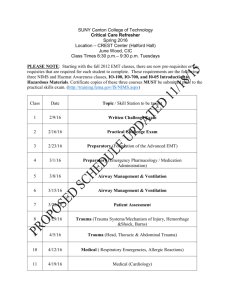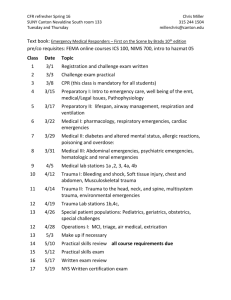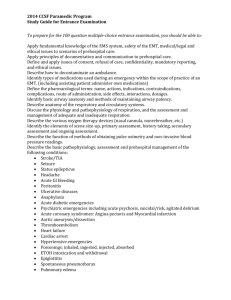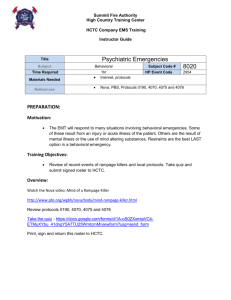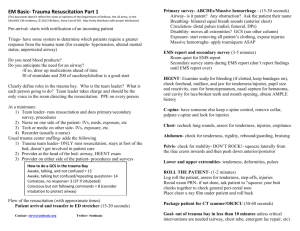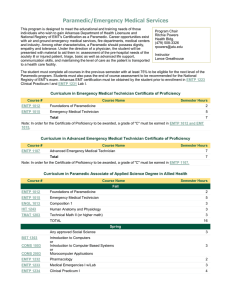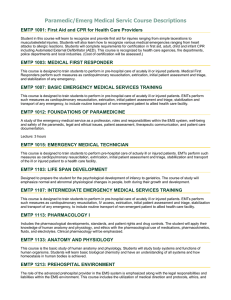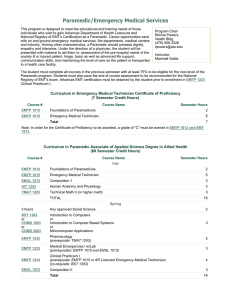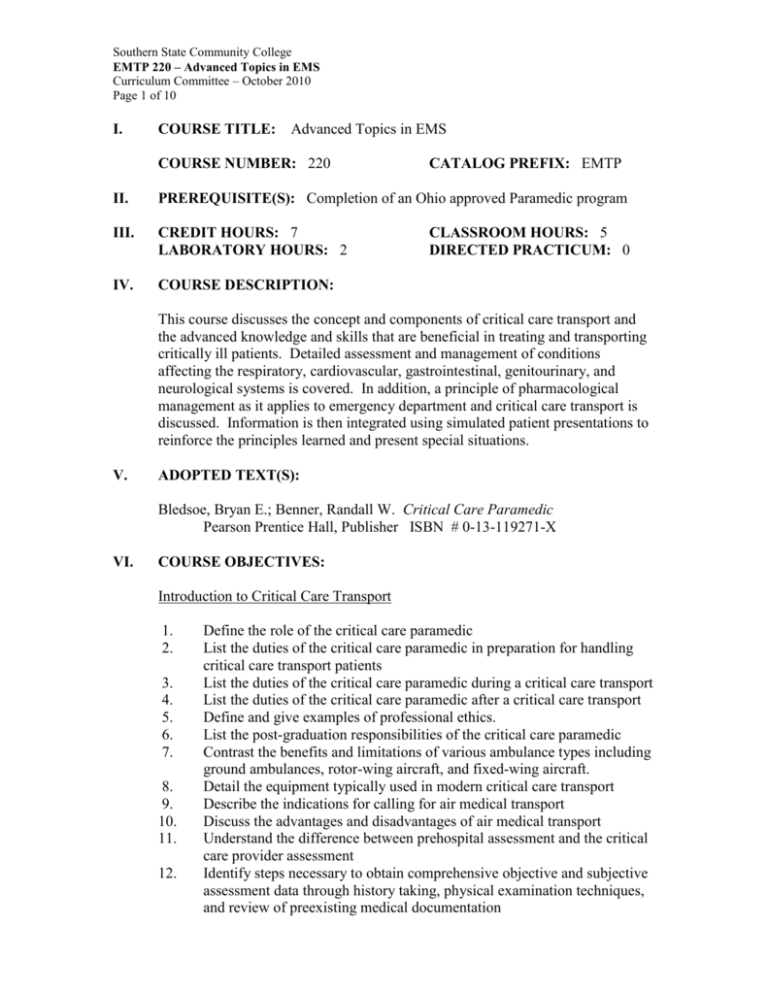
Southern State Community College
EMTP 220 – Advanced Topics in EMS
Curriculum Committee – October 2010
Page 1 of 10
I.
COURSE TITLE:
Advanced Topics in EMS
COURSE NUMBER: 220
CATALOG PREFIX: EMTP
II.
PREREQUISITE(S): Completion of an Ohio approved Paramedic program
III.
CREDIT HOURS: 7
LABORATORY HOURS: 2
IV.
COURSE DESCRIPTION:
CLASSROOM HOURS: 5
DIRECTED PRACTICUM: 0
This course discusses the concept and components of critical care transport and
the advanced knowledge and skills that are beneficial in treating and transporting
critically ill patients. Detailed assessment and management of conditions
affecting the respiratory, cardiovascular, gastrointestinal, genitourinary, and
neurological systems is covered. In addition, a principle of pharmacological
management as it applies to emergency department and critical care transport is
discussed. Information is then integrated using simulated patient presentations to
reinforce the principles learned and present special situations.
V.
ADOPTED TEXT(S):
Bledsoe, Bryan E.; Benner, Randall W. Critical Care Paramedic
Pearson Prentice Hall, Publisher ISBN # 0-13-119271-X
VI.
COURSE OBJECTIVES:
Introduction to Critical Care Transport
1.
2.
3.
4.
5.
6.
7.
8.
9.
10.
11.
12.
Define the role of the critical care paramedic
List the duties of the critical care paramedic in preparation for handling
critical care transport patients
List the duties of the critical care paramedic during a critical care transport
List the duties of the critical care paramedic after a critical care transport
Define and give examples of professional ethics.
List the post-graduation responsibilities of the critical care paramedic
Contrast the benefits and limitations of various ambulance types including
ground ambulances, rotor-wing aircraft, and fixed-wing aircraft.
Detail the equipment typically used in modern critical care transport
Describe the indications for calling for air medical transport
Discuss the advantages and disadvantages of air medical transport
Understand the difference between prehospital assessment and the critical
care provider assessment
Identify steps necessary to obtain comprehensive objective and subjective
assessment data through history taking, physical examination techniques,
and review of preexisting medical documentation
EMTP 220 – Advanced Topics in EMS
Page 2 of 10
13.
14.
Be able to incorporate all assessment and pertinent diagnostic findings into
a working field impression or diagnosis for management.
Become familiar with procedures to minimize complications of critical
care transports
Airway and Breathing Assessment and Management
1.
2.
3.
4.
5.
6.
7.
8.
9.
10.
11.
12.
13.
Discuss the importance of airway management and ventilation in modern
critical care transport
Detail the indications, contraindications, and techniques for the following
intubation procedures:
Digital intubation
Blind nastotracheal intubation
Sky hook technique
Lighted stylet
Retrograde intubation
List the four phases of RSI pharmacology
List the indications for RSI
Detail the role of analgesics and hypnotics in RSI
Review and detail the following induction agents:
Etomidate
Propofol
Fentanyl
Morphine
Ketamine
Midazolam
Diazepam
Lorazepam
Discuss the importance of premedication in high-risk patients undergoing
RSI
Detail the pharmacokinetics, including onset of action and duration of
effect, for the following nondepolarizing blockers:
Vecuronium
Atracurium
Rocuronium
Contrast the pharmacology of depolarizing and nondepolarizing
neuromuscular blocking agents
Discuss the indications, contraindications, insertion, and removal of the
following rescue airways:
Endotracheal Combitube (ETC)
Pharyngotracheal lumen (PtL) airway
Laryngeal mask airway (LMA)
Describe the process of identifying the possible difficult airway
Discuss management of the difficult airway
Discuss the role of noninvasive monitors in airway management and
ventilation
EMTP 220 – Advanced Topics in EMS
Page 3 of 10
Shock Assessment and Management
1.
2.
3.
4.
Define shock
Identify the stages of shock
Describe general treatment modalities involved in shock including
hemodynamic monitoring
Discuss the four classifications and subclassifications of shock
Hemodynamic and Cardiac Monitoring
1.
2.
3.
4.
5.
6.
7.
8.
9.
10.
11.
Define hemodynamic monitoring
Define the physiological difference between noninvasive vs. invasive
pressure monitoring
Identify common sites for arterial line insertion, central line insertion, and
pulmonary artery catheter insertion
List four complications of pulmonary artery catheter insertion
Identify the waveforms of RA, RV, PA, and PAWP
Define normal values of CVP, RV, PAP, PAWP, CO/CI, MAP, SVI,
SVRI, and PVRI
Discuss how the PA waveform changes when the pulmonary artery
catheter floats from the right ventricle into the pulmonary artery
Describe the management priorities of those patients at risk for complete
heart block
Using a simple chart, determine the presence of fascicular block
Describe the assessment, management, and ECG findings of hyperkalemia
and other electrolyte abnormalities
Describe the diagnosis and clinical implications of a right ventricular
infarction
Critical Care Pharmacology
1.
2.
3.
Define the role of critical care pharmacology
Understand the difference between pharmacodynamics and
pharmacokinetics
Describe the factors that can affect the administration of critical care
pharmacological agents
Interpretation of Lab and Basic Diagnostic Tests
1.
2.
3.
4.
5.
Discuss the importance of laboratory and basic diagnostic testing in
critical care transport
List the elements of a complete blood count and discuss what any
abnormal readings may indicate
List the elements of a coagulation panel and discuss what any abnormal
readings may indicate
List the elements of an electrolyte panel and discuss what any abnormal
readings may indicate
List the elements of a renal function panel and discuss what any abnormal
readings may indicate
EMTP 220 – Advanced Topics in EMS
Page 4 of 10
6.
7.
8.
9.
10.
11.
12.
List the five most frequently used cardiac markers
List the elements of a liver function panel and discuss what any abnormal
readings may indicate
List the elements of a urinalysis and discuss what any abnormal readings
may indicate
Discuss the importance of toxicological testing in critical care transport
Discuss the role of diagnostic imaging in medicine and briefly describe the
following:
X-rays
CT (CAT) scanning
Ultrasonography
Nuclear medicine
Magnetic resonance imaging (MRI)
Describe common physiological tests encountered in medicine
List the elements of an arterial blood gas panel and discuss what any
abnormal readings may indicate
Introduction to Trauma
1.
2.
3.
4.
5.
6.
Describe the history of trauma care and trauma systems in the United
States
Describe the basic structure of a regional trauma system in the United
States
Discuss the categories for trauma facilities in the United States and
characteristics and limitations of each
Describe the physics and biomechanics of trauma
Describe the initial assessment and priorities during resuscitation of the
trauma patient
Describe general considerations for transport of a severely traumatized
patient
Neurologic Trauma and Emergencies
1.
2.
3.
4.
5.
6.
7.
8.
Understand the mechanism underlying the profression of secondary
injuries after central nervous system (CNS) trauma
Develop neurologic assessment skills
Identify diagnostic tests and imaging used in the treatment of CNS-injured
patients
Identify the basic concepts of intracranial pressure monitoring, as well as
equipment and techniques utilized
Discuss the role of pharmacologic agents in reducing intracranial pressure
in the management of head and spinal injury patients
Identify common neurologic emergencies that may result in the need for
critical care intervention
Become familiar with the pathophysiology of thromboembolic and
hemorrhagic cerebrovascular accidents, as well as the treatment of both
Identify patients who are candidates for fibrinolytic therapy
EMTP 220 – Advanced Topics in EMS
Page 5 of 10
Thoracic Trauma and Pulmonary Emergencies
1.
2.
3.
4.
5.
6.
7.
8.
Identify common and life-threatening thoracic injuries based on anatomy
and mechanism of injury
Integrate the relationship between anatomy, kinematics, and assessment
findings to identify specific thoracic injuries
Describe general treatment modalities for the following thoracic injuries:
Tension pneumothorax
Hemothorax
Pneumothorax (both open and closed)
Flail chest
Blunt and penetrating cardiac injuries
Aortic rupture
Pulmonary contusions
Diaphragmatic rupture
Discuss ongoing maintenance care for chest tubes and the various drainage
systems that may be present
Describe basic pulmonary anatomy and physiology
Discuss and differentiate the pathology of common respiratory diseases
seen in the critical care environment
Define how the following assessment parameters assist in determining the
severity of a pulmonary emergency:
Inspection
Palpation
Percussion
Auscultation
Arterial blood gasses
Pulse oximetry
End tidal capnography
Discuss the basic management of the following pulmonary diseases:
Acute respiratory failure
Asthma
Chronic obstructive pulmonary disease
Acute respiratory distress syndrome
Pneumonia
Pneumothorax
Cardiovascular Emergencies
1.
2.
Understand and discuss the anatomy and physiology of the heart as it
pertains to the critical care paramedic
Understand the pathophysiology, clinical manifestation, diagnostics, and
management guidelines of patients with the following disorders:
Acute coronary syndrome
Aortic aneurysm
Aortic dissection
Cardiogenic shock
EMTP 220 – Advanced Topics in EMS
Page 6 of 10
3.
Adult cardiomyopathies
Cardiopulmonary arrest
Congestive heart failure
Hypertensive emergencies
Pericarditis, pericardial effusion, and cardiac tamponade
Valvular dysfunction
Understand the general considerations for interfacility critical care
transport
Gastrointestinal and Genitourinary Trauma and Emergencies
1.
2.
3.
4.
5.
6.
Discuss imaging and laboratory studies available to aid in the
identification of intra-abdominal injury
Describe the anatomy and physiology of the organs and structures that are
of concern in genitourinary trauma
Discuss imaging studies available to aid in the identification of
genitourinary injury
Describe basic gastrointestinal anatomy and physiology
Discuss diagnostic studies available to aid in the diagnosis of
gastrointestinal disease and complications
Understand how to manage various types of gastric management tubes that
may be encountered during transport
Trauma to the Head, Neck, and Face
1.
2.
3.
4.
Describe basic facial, neck, ocular, and auditory anatomy and physiology
Discuss the assessment and management of the patient with a facial injury
Discuss the assessment and management of the patient with an ocular
injury
Discuss the assessment and management of the patient with a neck injury
Burns and Electrical Injuries
1.
2.
3.
4.
Describe techniques used to identify and establish priorities for treatment
of the burn patient
Identify the techniques used for airway management and ventilation
support of the burn patient
Calculate the total percentage of body surface area involved using one or
more of the following methods:
“Rule of nines” (adult and pediatric)
“Rule of palms”
Lund and Browder chart
Identify and describe the depth classifications of burn injuries:
Superficial burns (first degree)
Partial-thickness burns (second degree)
Full-thickness burns (third degree)
Fourth-degree burns
EMTP 220 – Advanced Topics in EMS
Page 7 of 10
5.
6.
7.
8.
9.
Describe the various formulas used for burn resuscitation and the
techniques required to initiate and monitor fluid resuscitation
Discuss the use of pharmacological agents for the management of pain
associated with burn trauma
Describe the three types of airway injuries:
Carbon monoxide poisoning
Inhalation injury above the glottis
Inhalation injury below the glottis
Describe the specific assessment, management, and prognosis of burn
patients with the following mechanisms of injury:
Thermal burns
Chemical burns to the eyes
Electrical burns
Lightning strikes
Chemical burns
Radiation exposure
Discuss potential complications that the critical care paramedic should be
cognizant of while transporting the burn patient
Orthopedic Care
1.
2.
3.
Describe the skeletal anatomy and physiology, using appropriate medical
terminology
Discuss the primary concerns regarding treatment of orthopedic injuries
Identify simple orthopedic injuries from radiographic images
Pediatric, Geriatric, and Obstetrical Patients
1.
2.
3.
4.
5.
6.
7.
8.
9.
Analyze developmental aspects that necessitate the modification of
physical assessment parameters and intervention techniques for the
pediatric patient
Identify normal values pertaining to the pediatric patient
Discuss system pathophysiology and organ system decline as it pertains to
the geriatric patient
Discuss transport considerations and management of:
Pediatric patients
Geriatric patients
Obstetrical patients
Identify and discuss the physiological changes during pregnancy
Discuss the effects of disruption of normal uterine and fetal physiology
during critical care transport
Discuss why the critical care paramedic must remain aware of the special
concerns surrounding the assessment and management of the pediatric
patient
Understand the physiological differences between the adult and the
pediatric patient
Describe the pathophysiology, assessment, and management of various
OB-GYN emergencies
EMTP 220 – Advanced Topics in EMS
Page 8 of 10
Renal and Acid-Base Emergencies
1.
2.
3.
4.
5.
Describe the anatomical structures of the renal system
Understand the basic physiology of the renal system
Identify three major causes of renal failure
Describe the kidney’s role in acid-base physiology
Discuss the varying etiologies of acid-base disturbances
Infectious Disease Emergencies
1.
2.
3.
4.
VII.
Discuss the importance of infectious disease knowledge and prevention in
the critical care setting
Describe the basic types of disease-causing organisms
Detail the role of the critical care paramedic in infectious disease
prevention
Describe Universal Precautions and Body Substance Isolation Precautions
as they pertain to critical care transport
COURSE METHODOLOGY:
Lecture, discussion, skill demonstration, and practical scenarios will be utilized as
appropriate to the objectives.
VIII. GRADING:
Students will be required to complete written exams, quizzes, and/or homework
at the times designated by the course instructor. Late assignments will be
considered for half credit.
The student will also be graded on his/her performance of the competency based
skills. A grade of "S" will be recorded for satisfactory performance and a grade
of "U" will be recorded for unsatisfactory performance.
Grading will be recorded using the following schedule:
A = 90 – 100
B = 80 – 89
F = 0 – 79
Honesty and integrity are major elements in professional behavior and are
expected of each Health Sciences student. Cheating is considered unacceptable
behavior within all Health Sciences courses. Students having academic
difficulties should seek guidance assistance from the instructor, academic advisor,
or college counselor.
A student observed or found to be cheating on a test or assignment in any Health
Sciences course will be given a "zero" on the test or assignment. A written report
of the incident, signed by the instructor and the student, will be placed in the
student's file. This notice will remain on file and in effect for the remainder of the
student's enrollment in the Health Sciences Division. Should a second incident of
EMTP 220 – Advanced Topics in EMS
Page 9 of 10
cheating occur in any Health Sciences Division course, the student will be given a
failing grade for the course and will be dismissed from the Health Sciences
Division for one year. The "zero" grade for dishonesty will not be used as the
drop grade in a course in which a drop grade option is given.
IX.
COURSE OUTLINE:
Introduction to Critical Care Transport
Airway and Breathing Assessment and Management
Shock Assessment and Management
Hemodynamic and Cardiac Monitoring
Critical Care Pharmacology
Interpretation of Lab and Basic Diagnostic Tests
Introduction to Trauma
Neurologic Trauma and Emergencies
Thoracic Trauma and Pulmonary Emergencies
Cardiovascular Emergencies
Gastrointestinal and Genitourinary Trauma and Emergencies
Trauma to the Head, Neck, and Face
Burns and Electrical Injuries
Orthopedic Care
Pediatric, Geriatric, and Obstetrical Patients
Renal and Acid-Base Emergencies
Infectious Disease Emergencies
X.
OTHER REQUIRED TEXTS, SOFTWARE, AND MATERIALS
Approved student uniform
Watch with a second hand
Stethoscope
Bandage Scissors
XI.
EVALUATION:
There will be a total of four 100 point examinations. All exams may be
comprehensive. Students who achieve a score of less than 80 on an exam will be
given one opportunity to retest for a maximum score of 80. Any retests must be
scheduled with the instructor outside of regular class time and must be completed
within one week of notification of results. Quizzes/Homework will be assigned at
the instructor's discretion. No retests will be offered on quizzes.
An "S" grade is required on the evaluation of each skill discussed and
demonstrated. Failure to achieve an "S" grade within three attempts or within ten
days of the assigned date will result in a "U" grade for the skill and an "F" for the
course, regardless of the theory grade achieved.
The final course grade will be calculated by averaging the grades of the
examinations (75%) and the average of the quizzes/homework assignments
(25%).
EMTP 220 – Advanced Topics in EMS
Page 10 of 10
XII.
SPECIFIC MANAGEMENT REQUIREMENTS:
To meet the objectives of the course, students must attend all scheduled classes.
At the beginning of the quarter, all instructors will pass out a class schedule that
lists all class meetings. If a student must miss a class due to extenuating
circumstances, then the student is expected to call and inform the instructor by
either talking with the instructor or leaving a message should the instructor not be
available.
Students will be allowed two class absences. Unexcused absences over two times
may result in a drop of one letter grade from the final grade, i.e. the third absence
would reduce a final grade of "A" to a "B". Two instances of significant
tardiness or leaving early will be considered to be equivalent to an absence for
purposes of this calculation. You will be expected to pass a quiz in return to
school for the information you missed.
Any student, who misses a scheduled competency, either demonstration or checkoff, must make an appointment with the instructor within one week of return to
school to make up this portion of class. Failure to do so will result in a "U" for
the competency, therefore, failure for the course. It is the students' responsibility
to make these arrangements.
Note: Work submitted in this class may be seen by others. Others may see your
work when being distributed, during group work, or if it is chosen for
demonstration purposes. Other instructors may also see your work during the
evaluation/feedback process. There is also a possibility that your papers may be
submitted electronically to other entities to determine if references are cited
appropriately.
Need for assistance: If you have any condition or situation which will make it
difficult for you to carry out the work as outlined, please notify the instructor as
soon as possible. Students with disabilities may contact the Disabilities Services
Office, Central Campus at 800-628-7722 or 937-393-3431, ext. 2604

